Affiliate disclosure: This post may contain affiliate links. Please see our Privacy Policy.
Strawberry wine is simple to make at home with minimal equipment. After you’ve canned your fill of strawberry jam, a small batch country wine is a great way to preserve strawberries for year round use.
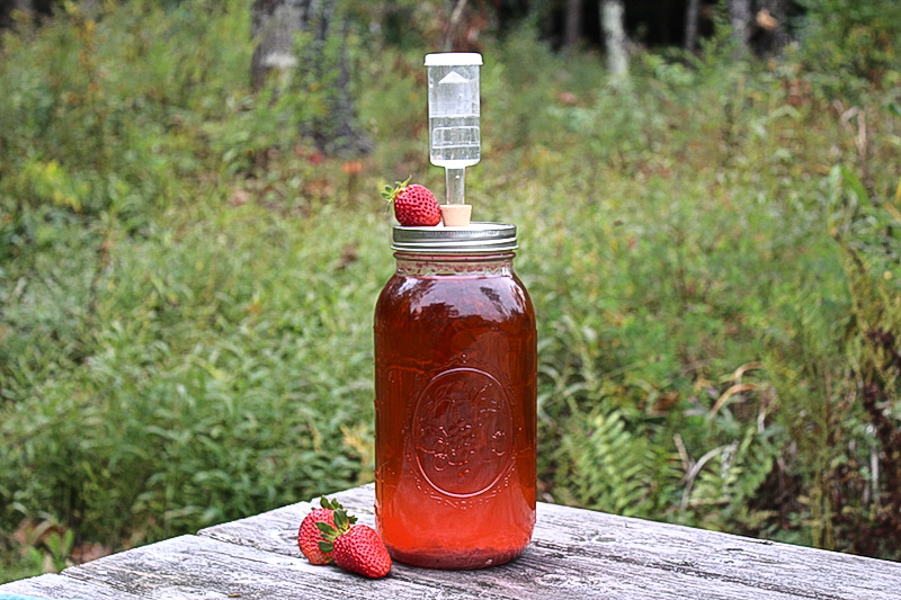
Growing up, my mom was a huge country music fan. Our local station had a pretty limited mix, and I must have heard the song “Strawberry Wine” hundreds of times in my youth. I can still hear the corus as I type,
“Like Strawberry Wine, seventeen, the hot July moon saw everything. My first taste of love, oh bittersweet, and green on the vine, like strawberry wine…”
Now that I’ve made my own strawberry wine, I can tell you that it’s in no way bittersweet and there’s nothing green on the vine about it. The song’s romantic, but a more accurate chorus would have been something along the lines of,
“Like strawberry wine, innocent and sweet. A kiss on the lips, with a taste so complete. Gentle at first, but then the flavors seep, into my heart, like strawberry wine…real strawberry wine.”
See, I’m no songwriter. I’m a winemaker, and I won’t quit my day job.
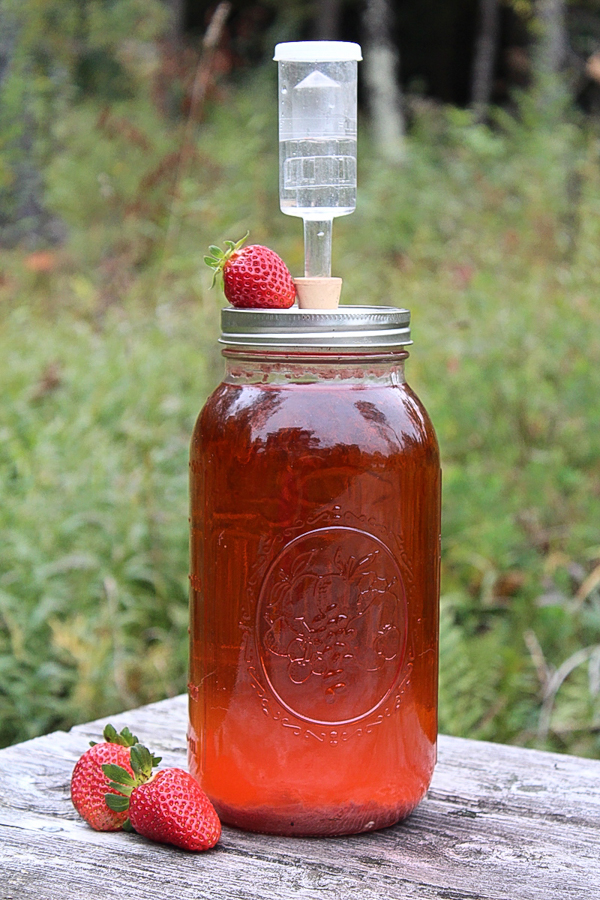
We started this batch of strawberry wine with some of the first everbearing strawberries of the year. The first spring berries are a bit on the small side as the plants wake up, but those same plants keep producing all summer. We harvest the last berries in November, and those last few are the beauties sitting right next to the mason jar fermenter above right before bottling.
I love making wine in a mason jar because it means I can just put the chunky fruit right in the jar and allow the sugar to do the juicing. Since strawberries are so soft, there’s no need to even chop them.

It’s going to look a bit strange, but once the strawberries are in the mason jar, just add the sugar. The sugar is going to completely cover the berries and you’ll be thinking “this can’t possibly be right…”
Wait a few hours and you’ll see. The sugar will completely dissolve the strawberries and extract their juice for the wine. Putting strawberries through a juicer just purees them, so this is a much more efficient method.
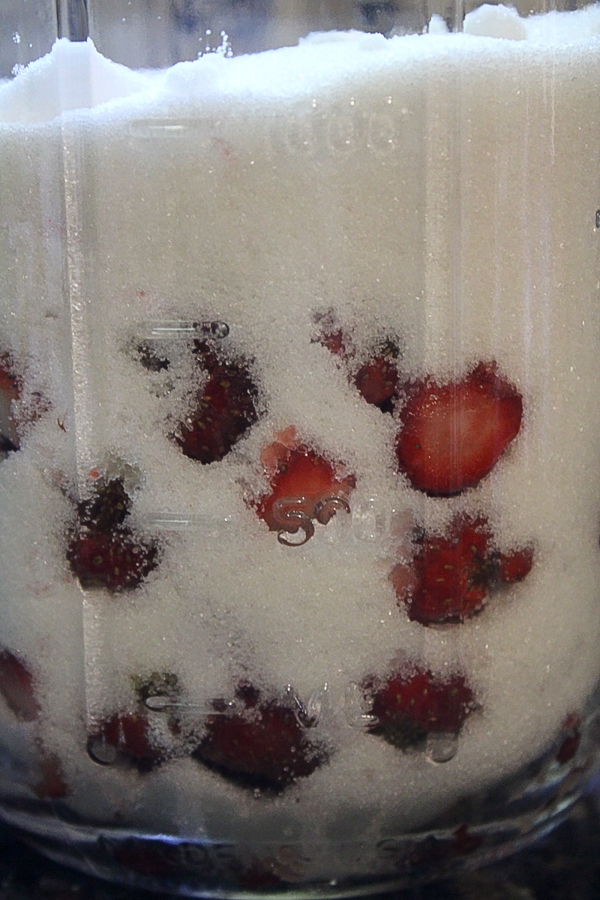
Here they are a few hours later, all the sugar dissolved and the strawberry juice extracted. Use a wooden spoon to muddle it down a bit to break up the last bits of strawberries and then you’re ready for the next step.
If you don’t have a mason jar fermenter, you can just do this juice extraction step in a bowl and then pour the whole mass into a traditional fermenter.
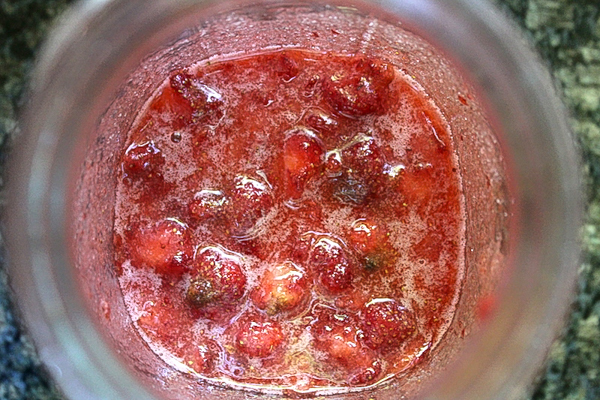
After juicing the strawberries with sugar, it’s time to add in the rest of the ingredients and a bit of water to fill the jar completely. Be sure to dissolve the yeast in a bit of water and allow it to bloom for at least 5 minutes before adding it into the strawberry wine because going straight from dehydrated to a high sugar solution can shock the yeast. Be nice, give them a minute to wake up before putting them to work.
At this point, it’s time to seal up the airlock and let the yeast do their work. Leave the strawberries in for the primary fermentation for about 2-3 weeks, and then they’ll be filtered out as you rack the strawberry wine into a secondary fermenter for another 4-6 weeks.
There are a lot of different airlocks that fit on a mason jar, most designed for making sauerkraut and vegetable ferments. There’s no reason you can’t use those same kits to make strawberry wine or any other fruit wine, mead or beer. There are a number of brands to choose from. Any of these will work.
I use a kit by Fermentools that looks a lot like a homebrew setup, and if you choose to do bigger batches later you’ll need the rubber stopper and water lock that are included in the kit.
I recently tried out these new silicone fermentation lids from Mason Tops and loved them because they’re super easy to clean. Since there’s no airlock at the top you have to watch for tiny bubbles within the fermenter to determine when the fermentation is complete, which can be a bit tricky.
I also have a wide mouth one-gallon jar equipped with a waterlock which is handy for making full one-gallon batches without worrying about cleaning out the narrow neck on a traditional fermenter.
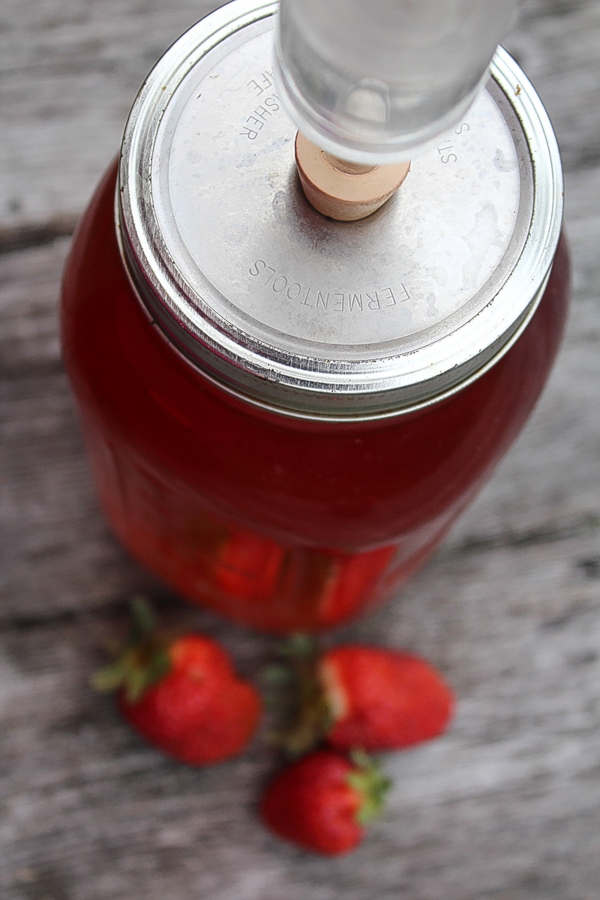
Since most people will be making a one gallon batch of strawberry wine, I’ve written this recipe for a full gallon. If you want to make a micro-batch in a quart jar, just divide by 4. Similarly, divide by 2 for a half gallon batch. Or you know, go crazy and multiply by 5 for a full five gallons of strawberry wine, and enjoy 20 bottles of tasty bliss.
For more details on the process of winemaking, read this guide to making small batch wine.

Strawberry Wine
Ingredients
- 4-5 lbs strawberries
- 2 lbs sugar
- 1 tsp acid blend
- 1 tsp yeast nutrient
- 1/8 to 1/4 tsp tannin powder
- 1/2 tsp Pectic Enzyme
- water to fill
- 1 wine yeast
Instructions
- Place the strawberries and sugar into a large bowl or directly into your fermentation vessel. Allow the sugar to pull the juice from the strawberries for a few hours.
- Add the remaining ingredients (except wine yeast) and fill with water to within a few inches of the top of the fermentation vessel. Give it a stir or shake to combine the ingredients.
- Dissolve a packet of wine yeast in about 1/4 cup of water and allow it to rehydrate for at least 5 minutes. Add the dissolved yeast into the wine base and cap the mixture with a water lock.
- Allow the mixture to ferment for about 2 weeks and then use a siphon to rack the wine into a new fermenter. Filter through a fine mesh strainer as you go to remove any strawberry chunks and leave any sediment behind.
- Cap with an airlock and allow the strawberry wine to ferment in secondary for about 6 weeks, or until fermentation is complete, before bottling.
- Bottle the wine, leaving behind the sediment. Cork bottles and allow it to age for at least a month, preferably 3-6 months before drinking.
Notes
Ingredient Substitutions
If you’d like to try to make this wine without normal pantry staples, here are a few substitutions (see the article on ingredient substitutions for more details):- 1 tsp Acid Blend = 1 TABLEspoon lemon juice
- ⅛ tsp Tannin Powder = 1 cup strongly brewed black tea
- 1 tsp Yeast Nutrient = ¼ cup golden raisins (sultanas)
- 1 tsp Pectic Enzyme = freeze the fruit for 1 week before making the wine to break down pectin
Nutrition
Nutrition information is automatically calculated, so should only be used as an approximation.
Ingredient Substitutions
If you’re hoping to make strawberry wine with just the ingredients you have on hand in your kitchen right now, there are a few easy substitutions for the winemaking additives listed above. I have a full rundown of all the substitution options in my post on Winemaking Ingredient Substitutions, but here’s a place to start:
The 1 teaspoon of acid blend can be replaced with 1 TABLEspoon of lemon juice, preferably fresh or bottled organic preservative free, as some of the bottled stuff often contains preservatives that can inhibit the yeast.
For the tannin powder, you can substitute 1 cup of strongly brewed black tea. Make a cup of black tea using a cheap tannin rich black tea (like lipton), remove the tea bag, and then pour the cooled tea into the carboy in place of some of the water.
In place of the yeast nutrient, you can add about ¼ cup of raisins. Strawberries don’t have all the right nutrients for feeding the yeast, but grapes do. For mild fruit wines like this strawberry wine, I’d suggest using golden raisins (sultanas) as they have a more neutral flavor and regular raisins will give the wine a slight molasses flavor.
The Pectic Enzyme is optional, and just helps break down natural pectins in the fruit to clarify the wine. They’ll break down on their own over time, you just might need to rack the wine into a clean carboy an extra time or two, leaving the sediment behind. Or…freezing the fruit before making the wine helps break down pectin, and it also helps extract juice. Pectin is reduced by 50% in fruit after 1 week in the freezer, so freeze it for a week before you get started. Or, you can leave your wine a bit cloudy.
The one thing that is hard to get around is the wine yeast. Don’t use bread yeast, it makes wine taste like bread, and dies out when the alcohol level is only at around 2-3%. That’s not high enough to preserve the wine. You really do need some kind of wine yeast, which are specialty strains that don’t give off flavors to the wine during fermentation.
If you’re absolutely committed to not buying winemaking ingredients, you can try cultivating wild yeast by placing organic grapes mashed up in a jar with a bit of sugar water until it begins to bubble. It’s kind of a wild card, and you may or may not catch a good strain, but either way the results are better than with bread yeast.
More ways to use strawberries:
More wine recipes:
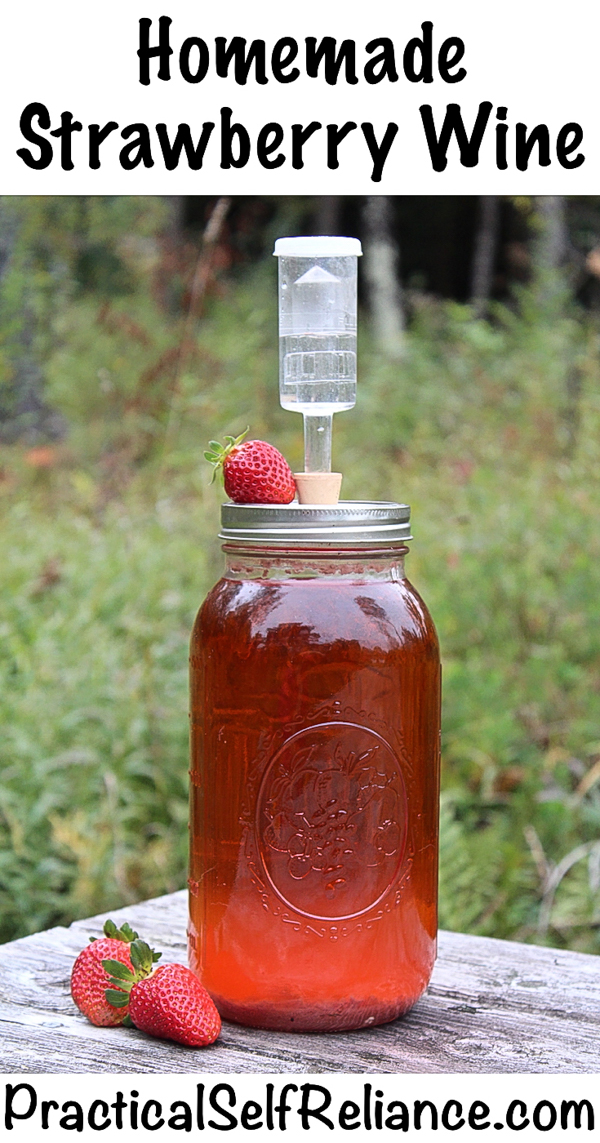
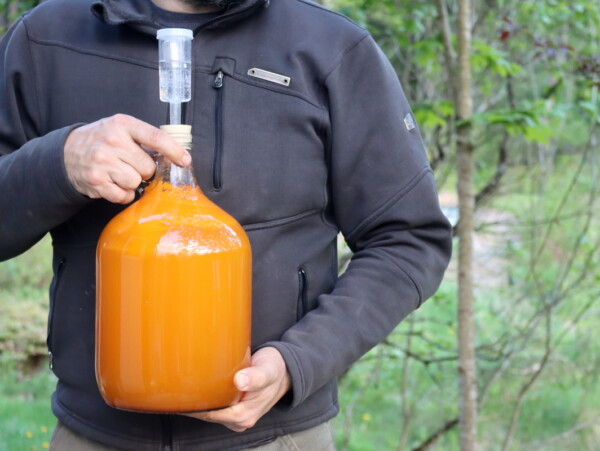



Hi Ashley. I just put my first batch together and marked the calendar for 2 weeks. It smells wonderful. Where should I store this while it’s doing its thing? 🙂
You can store it anywhere that’s convenient for you. It just needs to sit at room temperature.
I have read s may of your wine recipes I want to make them all! My question is about bottling. It said to leave behind sediment, I get that but, how do you bottle? Do you syphon in to the bottles? Thank you.
Yes, you will want to siphon the wine into the new fermentation vessel leaving the sediment behind in the first.
My first batch started last night so far all is well can not wait untill done . Also do you have a recipe for dandelion wine
That’s great! Keep us updated on it. We sure do have a dandelion wine recipe. https://practicalselfreliance.com/dandelion-wine-recipe/
I m making ur strawberry wine , was confuse about water so I m making with 10 lbs strawberry nd used 3 gallon water , is that will b ok ?
I m making ur strawberry wine , was confuse about water so I m making with 10 lbs strawberry nd used 3 gallon water , is that will b ok ?
For 3 gallons of liquid, you’re looking at more like 12 to 15 pounds of strawberries. It will still work but the strawberry flavor most likely won’t be as strong.
I have citric acid in my cupboard. Can I use that as the acid mix?
The acid blend is a mix of several different acids including citric acid. You could try it out and see but you may not get the same results.
Hey Ashley! Just put a batch in primary. I’ll let ya know how it turns out. Thanks for sharing some great recipes!
You’re welcome. We can’t wait to hear how it turns out.
After racking my wine turned out a little dry and bitter. How much sugar should I add to sweetener a one gallon batch.
You can find some information on back sweetening in this post on apple wine. https://practicalselfreliance.com/apple-wine/
How much water to add to this recipe? You said add water but not how much? What size batch are you making? 1 gall, 2 or 3….? Thanks.
How much water to add to this recipe? You said add water but not how much? What size batch are you making? 1 gall, 2 or 3….? Thanks.
The recipe is for one full gallon batch. Fill water a few inches from the top of your one gallon fermentation vessel.
Hello! I’m currently in the process of making this wine. I’m in the primary fermentation stage – I have the strawberry mixture in a mason jar fermenter with an airlock. It’s been fermenting for a week now. The first few days it was bubbling quite a bit but now it’s not bubbling at all. Does this mean I should rack it into a secondary container? Should I just leave it be for another week in primary fermentation? Thank you so much!
If you watch the airlock for several minutes with no bubbles, it’s ready to move to secondary. Often that’s around 7-10 days, but sometimes it’s as long as 14 and other’s it’s as short as 4-5, depending on your yeast, ambient temperature, etc. You may well be ready.
Thank you! Just one more question – how would I know if secondary fermentation is complete? I racked it into the secondary fermenter and it’s not bubbling – is that normal?
Not bubbling much in secondary is normal. The fermentation is much slower, and if you watch it for a REALLY long time it’s probably bubbling every hour or so. I usually give it 4 to 6 weeks in a cool dark place to slowly work through the last of the fermentation. In this stage, it’s less about building alcohol, and more about enzymes and other fun stuff developing the flavors. So long as the water lock has water in it (and watch that, it’ll evaporate over time), there’s not really “too much” time in secondary. If it still has a lot of sediment or any fruit bits that made it through, rack it again after a week or two, but other than that, leave it alone for 4-6 weeks and then bottle.
If in a pinch or say, during off season, can you use frozen strawberries?
Yes, frozen strawberries would still get the job done.
Thanks for this recipe! How do you strain the strawberries when moving to secondary fermentation? You keep the must for primary right?
Correct!
How would i multiply the ingredients for a 5l Carboy like used in the blueberry wine?
Yup!
Do i need to sweeten it back after fermentation or will there still be sugar left?
It should be sweet enough as is, but everyone’s tastes are different so if you’d like it sweeter, go ahead and add more.
This looks amazing, and I can’t wait to try it! I have a tree full of apricots right now, would this recipe work for apricots as well? Thank you!
You might try substituting apricots in this peach wine recipe instead. https://practicalselfreliance.com/peach-wine/
Thank you for helping me start my wine making journey! Your directions and links made your recipes so doable! I have started aging longer in carboys to allow more sediment fall out before bottling, but for those “beginner’s” bottles I pour the wine through a coffee filter before drinking and they’re fine. The color and taste are superb! I’ve been sharing this site with others. Thank you so much!
You’re very welcome. So glad you’re enjoying making wine. Thanks for sharing.
Can you use champagne yeast? It’s what I have on hand from making sweet mead
Yup, champagne yeast is great. I always have that one on hand, and it is a good neutral substitute for most any wine.
What would you say the alcohol % is of this? I wanna learn how to make my own wine but I don’t want to make something that equates to the same ALC% as a beer, lol. I’m super in love with this recipe!
Honestly, I never measure the alcohol content of my wines, but I’d guess most come out between 12 and 18%.
After about two weeks .I think my wine needs a little more strawberrys.is that possible
Hi Ashley, do you stir your strawberries around during the fermentation? The less I have to fuss over this the happier I will be.
I don’t =)
I forgot to ad the acid and I have completed the first fermentation. Should I leave it out or put it in with the racking?
You can do either, but personally I’d add it, it’ll improve the finished flavor.
Is a water lock and an airlock the same thing? Thx!
Yup!